Despite being around for many years, carbon dioxide monitors have only begun to take off recently. The monitors – ideal for identifying poor indoor air ventilation – have since become commonplace in thousands of individuals’ pockets, backpacks, homes, and offices worldwide.
However, there are now so many carbon dioxide monitor choices on the market that it’s become challenging to make the correct purchasing decision. Which monitors are portable? Which monitors have accompanying apps? And, above all, which monitors accurately measure the carbon dioxide concentration?
Since I have extensive experience with carbon dioxide monitors, I wanted to put together an article discussing what I believe are the best monitors for each situation. I’ve only included monitors in this list that I have first-hand experience with. Therefore, while this list isn’t exhaustive, it includes many of the most popular consumer-grade carbon dioxide monitors. I chose not to include monitors I haven’t experienced because I believe it’s disingenuous to recommend something I haven’t tried.
Now, I mentioned consumer-grade in the above paragraph because this article is aimed entirely at users looking to pick up a consumer-level monitor. If you’re a working professional needing a carbon dioxide monitor, you’ll want to check out a NIST-calibrated device such as those offered by Forensics Detectors.
On the other hand, suppose you’re looking for something less specialist-orientated, such as a monitor to identify poor ventilation, viral transmission chance, or the cognitive impact of carbon dioxide. In that case, you’re in the right place.
As always, I am open to suggestions for monitors to include on this list. If you know of a carbon dioxide monitor I’ve overlooked, please let me know on the forum. I am constantly expanding this list, and I would love to know what you want to see included. Now, with that out of the way, let’s get started!
Subscribe to BreatheSafeAir
Learn about the best carbon dioxide monitors, get discounts, and more!
This post contains affiliate links. For more information, please refer to my affiliate disclaimer.
Information on this blog is for informational purposes only. Readers are encouraged to confirm the information herein with other sources. Furthermore, this information is not intended to replace medical advice from professionals. This website assumes no responsibility for the accuracy of the information, which is subject to change without notice.
Why Should I Monitor Carbon Dioxide?

The first question we need to answer before diving deeper is obvious – why should I even be bothered monitoring carbon dioxide? Well, with a growing body of evidence showing how harmful carbon dioxide can be – even in common indoor concentrations – there is ample evidence showing why it’s essential to monitor the gas.
Recently, carbon dioxide monitoring has gained a lot of attention as it’s been found that carbon dioxide levels can be a proxy for the transmission chance of COVID. That is to say, when in a public space (or anywhere with other people present), high carbon dioxide levels can indicate the COVID-19 risk.
Of course, while COVID-19 is fairly getting all the current media attention, the use of carbon dioxide monitors isn’t limited to this virus alone. Since carbon dioxide levels reflect ventilation, these monitors can also show the transmission chance of other airborne pathogens.
Therefore, one great reason to use carbon dioxide monitors is to identify poor indoor ventilation and act on it. This can let you know when it’s a good idea to don your favourite disposable mask in public spaces.
However, while COVID-19 has massively boosted the popularity of monitoring carbon dioxide, it’s far from the only reason to keep a close eye on the gas. I would even argue that this isn’t the primary reason for monitoring carbon dioxide.
That’s because carbon dioxide has a large range of impacts on its own. It’s been tied to drowsiness, poor sleep quality, decreased cognitive performance, and more. Although these may seem minor, they’re anything but that.
A Harvard study found that cognitive performance decreases by 50% at only 1400ppm (parts per million). 1400ppm is far from a high concentration – if you’re sitting in a bedroom, on a bus, or in a cafe with poor ventilation while reading this, you’re probably experiencing this cognitive decline.
The same study also found that at 950ppm – an even more common carbon dioxide concentration – our cognitive performance declines by around 15%. This means that your brain is slowed down anytime you are in a poorly ventilated indoor environment.
Furthermore, excess indoor carbon dioxide concentrations have been found to lead to stress, kidney calcification, and bone demineralisation – all serious conditions avoidable with good ventilation.
The impacts of carbon dioxide go deeper than this; however, we still have a lot of research to do in the field. Only recently was indoor carbon dioxide identified as something we should be worried about, and it’s even more recent that the media began reporting on it.
With that said, even with more findings constantly coming to light, we already know that monitoring carbon dioxide is critical. Not only can having a carbon dioxide monitor indicate the transmission chance of airborne pathogens, but it also allows us to know when ventilation is necessary. Without this information available, you’re likely performing sub-optimally.
Features to Look For in a Carbon Dioxide Monitor
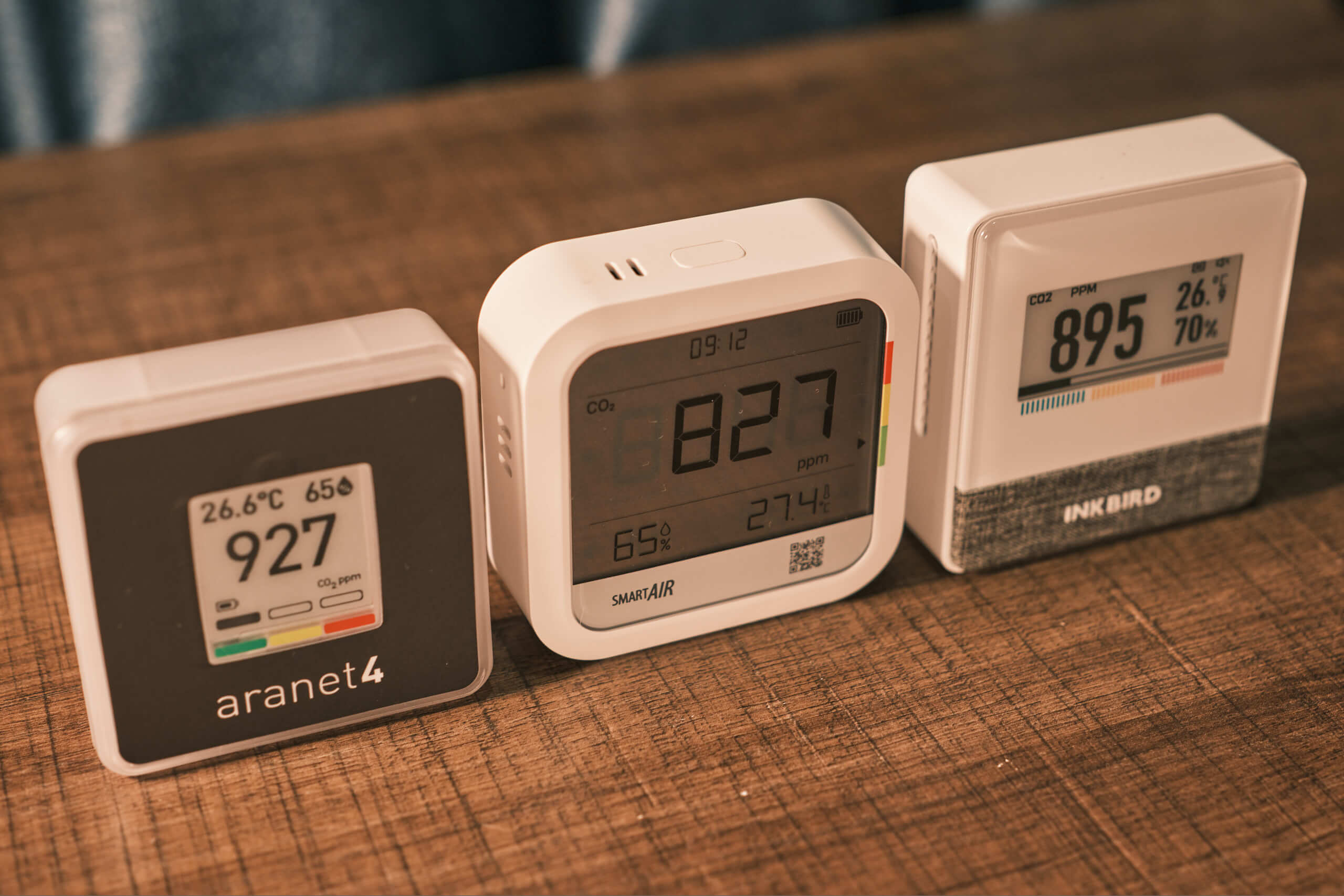
When it comes to purchasing a carbon dioxide monitor, there are a few factors you’ll want to keep in mind. While these aspects individually don’t guarantee a good product, all good products have these features in common.
Please keep in mind these are just the bare essentials. Depending on your preferences, you may also want to look for a carbon dioxide monitor with other features – such as a large screen or good portability. Here are a few minor features worth looking out for, depending on your preferences:
- Connectivity
- Configurable alarm/notification thresholds
- E-ink screen (visible + long battery life)
- Compact size
- Rechargeable battery
- Updateable
1. NDIR Sensor
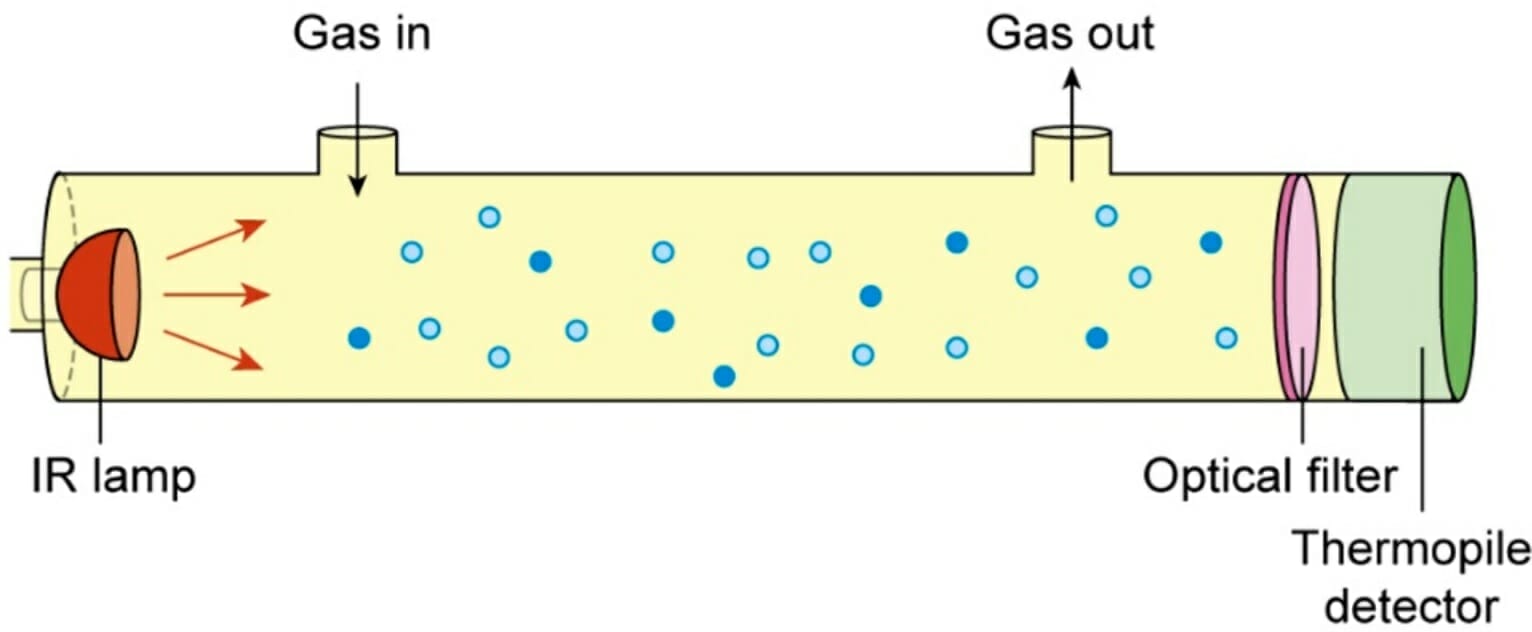
NDIR Sensor. Image source.
NDIR stands for non-dispersive infrared; these sensors are the gold standard for carbon dioxide monitoring. These sensors have a chamber where air enters – normally passively, but some monitors will have an intake fan. Once the air is inside the chamber, a beam of light specifically set to the wavelength of carbon dioxide will be activated. On the opposite side of the chamber, a receptacle monitors how much light makes it across the chamber.
Since carbon dioxide absorbs the light (at around 4 microns in wavelength), monitoring how much reaches the other side of the chamber indicates how much carbon dioxide is present in the air. While NDIR sensors can drift over time (which is why you’ll want a device that features manual recalibration), they tend to remain accurate for many years due to how they measure the gas.
The two other common sensor types are metal oxide semiconductors and electrochemical sensors. However, both of these sensors can be thrown off by other substances in the air that can impact readings. Furthermore, they tend to drift more than NDIR sensors, especially electrochemical ones.
It’s worth noting that photoacoustic sensors have recently gained some attention. These sensors cost around the same as NDIR sensors and are also accurate, but they have a few caveats (they tend to lose accuracy at higher temperatures – however, this shouldn’t make much of an impact since these monitors are usually used indoors). Photoacoustic sensors are common in devices where a small size is the priority, as they’re much smaller than NDIR sensors. If you keep in mind their limitations in warmer temperatures, they can also be very accurate.
2. Manual Recalibration
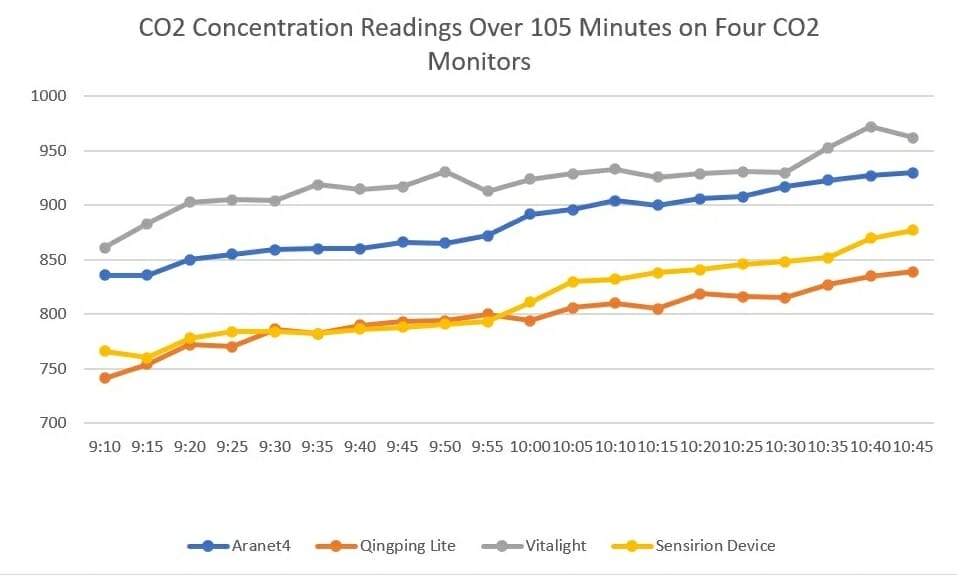
A lack of recalibration can lead to skewed readings.
While NDIR sensors are accurate, they do suffer some issues. One of these issues is sensor drift. Over time, it’s possible (and very likely) that your carbon dioxide monitor will start to provide skewed measurements. This is called sensor drift and can be caused by a range of variables.
Since sensor drift can impact any consumer-grade carbon dioxide monitor, it’s important to have a way to counter this passive drift. The best way to do this is to manually recalibrate your device occasionally.
The recalibration process is normally quite straightforward and involves taking your carbon dioxide monitor outside for a few minutes. This gives the monitor time to create a new baseline from the atmospheric carbon dioxide (normally around 420ppm, but it can vary).
Since every carbon dioxide monitor is susceptible to sensor drift, it is important to purchase a monitor that allows for manual calibration. While some devices offer auto calibration as a ‘feature’, this can cause issues when the device isn’t taken outside for long periods of time (to create a new baseline value).
3. Single-Beam or Dual-Beam
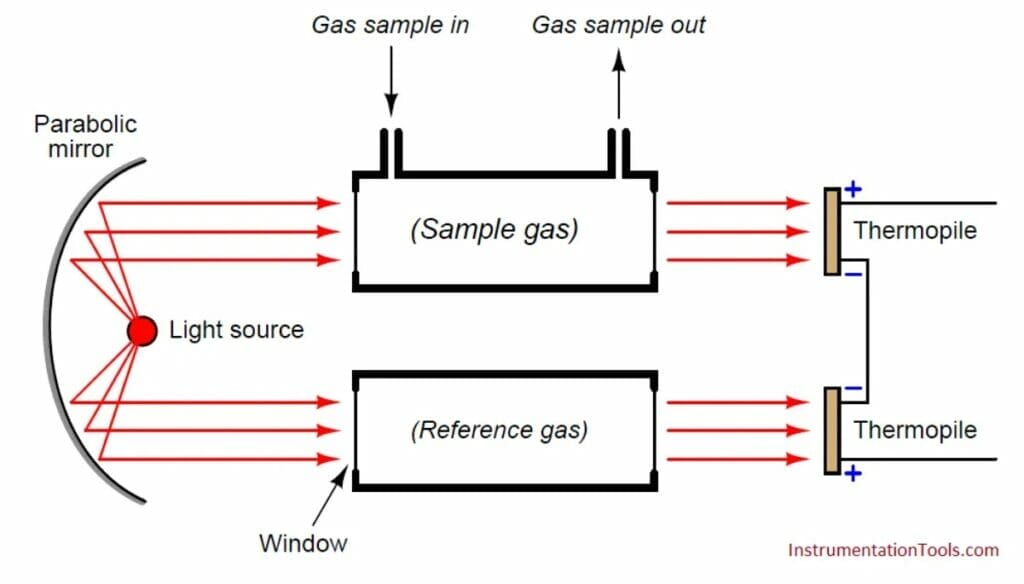
Dual-beam NDIR. Image source.
Within NDIR, there are two sensor types – single-beam and dual-beam. Both operate in exactly the same fashion and have the same potential for accuracy. The difference, however, is that dual-beam NDIR sensors have a second reference beam normally used once daily.
This second beam is typically factory set and is used to automatically calibrate the primary sensor, which is constantly being used and can have more drift. Theoretically, this allows the device to remain more accurate without manual calibrations.
Senseair (a big sensor company which makes both single-beam and dual-beam NDIR sensors) states that dual-beam NDIR is not particularly effective in the long term. While dual-beam products may be more accurate out of the box (close to their factory calibration), many variables can cause readings to drift – even on dual-beam sensors.
Therefore, while some companies will heavily advertise their use of a dual-beam sensor, it’s far from an essential feature. Over time, both single-beam and dual-beam NDIR will require calibration and be similarly accurate. The one advantage of dual-beam NDIR is that your monitor should be accurate without user input while it’s new.
4. Historical Data
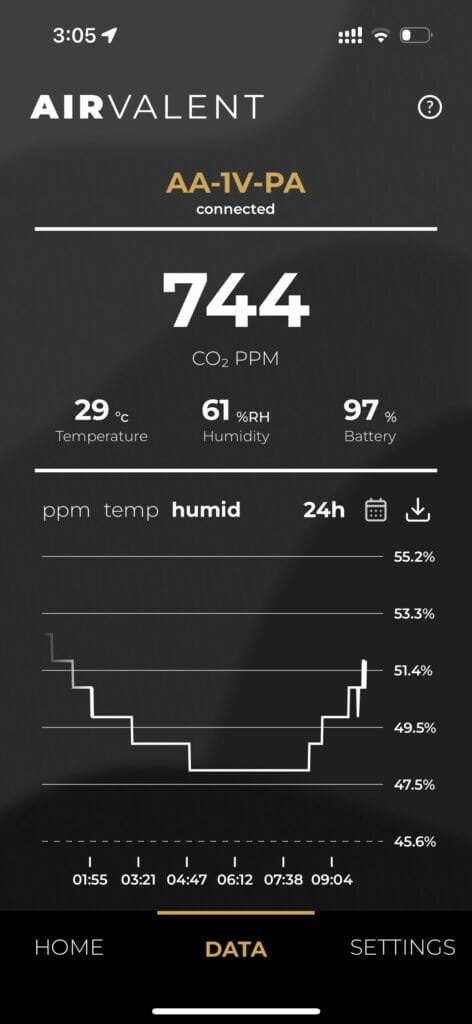
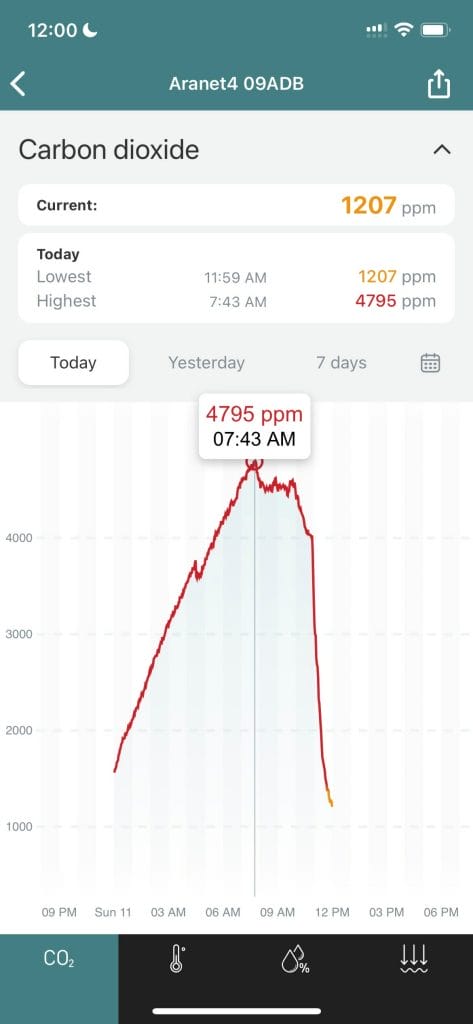
Left: AIRVALENT monitor historical view. Right: Aranet4 historical view.
You can view and analyse data on most carbon dioxide monitors in two ways. The first is on the device itself. However, this has some big downsides – specifically, you can only get information on carbon dioxide concentrations at the given moment. There is no way to view historical data.
Some higher-end devices fix this issue by allowing the user to view data on an app or export it to a spreadsheet. This is incredibly useful as it can allow you to identify ventilation trends and compare data from different periods. Want to know if the carbon dioxide concentrations increase while you’re sleeping? You won’t be able to see this data on a monitor unless it supports a historical data view.
Some people will consider this feature unnecessary, but I highly recommend purchasing a monitor with such a feature if you can afford it. On this list, devices like the Aranet4 and Qingping monitors support data exporting and viewing via an app.
5. Other Sensors

Sensors and accuracy on the Aranet4.
Most carbon dioxide monitors feature more than just a carbon dioxide sensor. Nearly every monitor on this list also has a relative humidity and temperature sensor, and while these aren’t necessary, they are nice additions to have. While carbon dioxide is a good indicator of when ventilation is needed, seeing the humidity and temperature provides deeper insight into overall air quality.
Some devices on this list offer more complete sensor arrangements, with PM2.5, PM10, tVOC, and atmospheric pressure sensors. While these are unnecessary on a carbon dioxide monitor, they are great on indoor air quality monitors.
When purchasing a carbon dioxide monitor, you should ask yourself, ‘Do I need these extra sensors, or could I find them beneficial?’ If the answer is yes, you should look at a device that includes them.
6. Battery Life
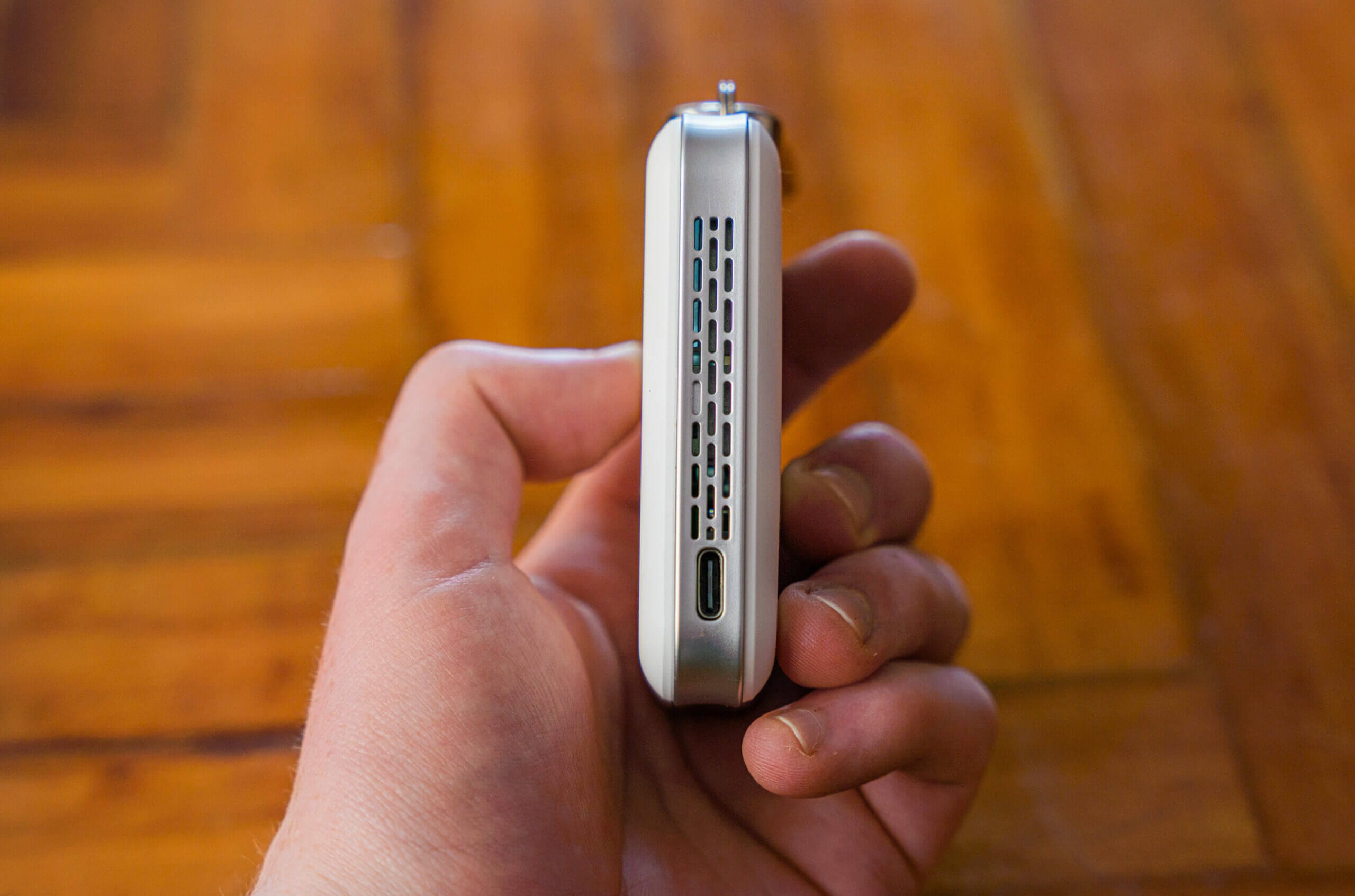
The Vitalight Mini CO2 Detector has an eight-hour battery life with Type-C charging.
When it comes to carbon dioxide monitors, battery life can vary wildly. Some monitors will have only a couple of hours of battery life (or none!), while some can last as long as four years! To say there is a crazy level of variation in battery life might be an understatement!
When deciding which carbon dioxide monitor best suits your needs, you’ll want to consider battery life. If you are looking for a desk-based solution to be used at home, you won’t need a device with long battery life. On the other hand, if you want a portable monitor to take everywhere, you’ll want to look for the longest battery life possible.
You’ll also want to consider how the device is powered. Does it require AA batteries? Is it USB-rechargeable? If so, what kind of connection does it use? Although many people are indifferent, some prefer a USB Type-C compatible device.
Best Carbon Dioxide Monitors
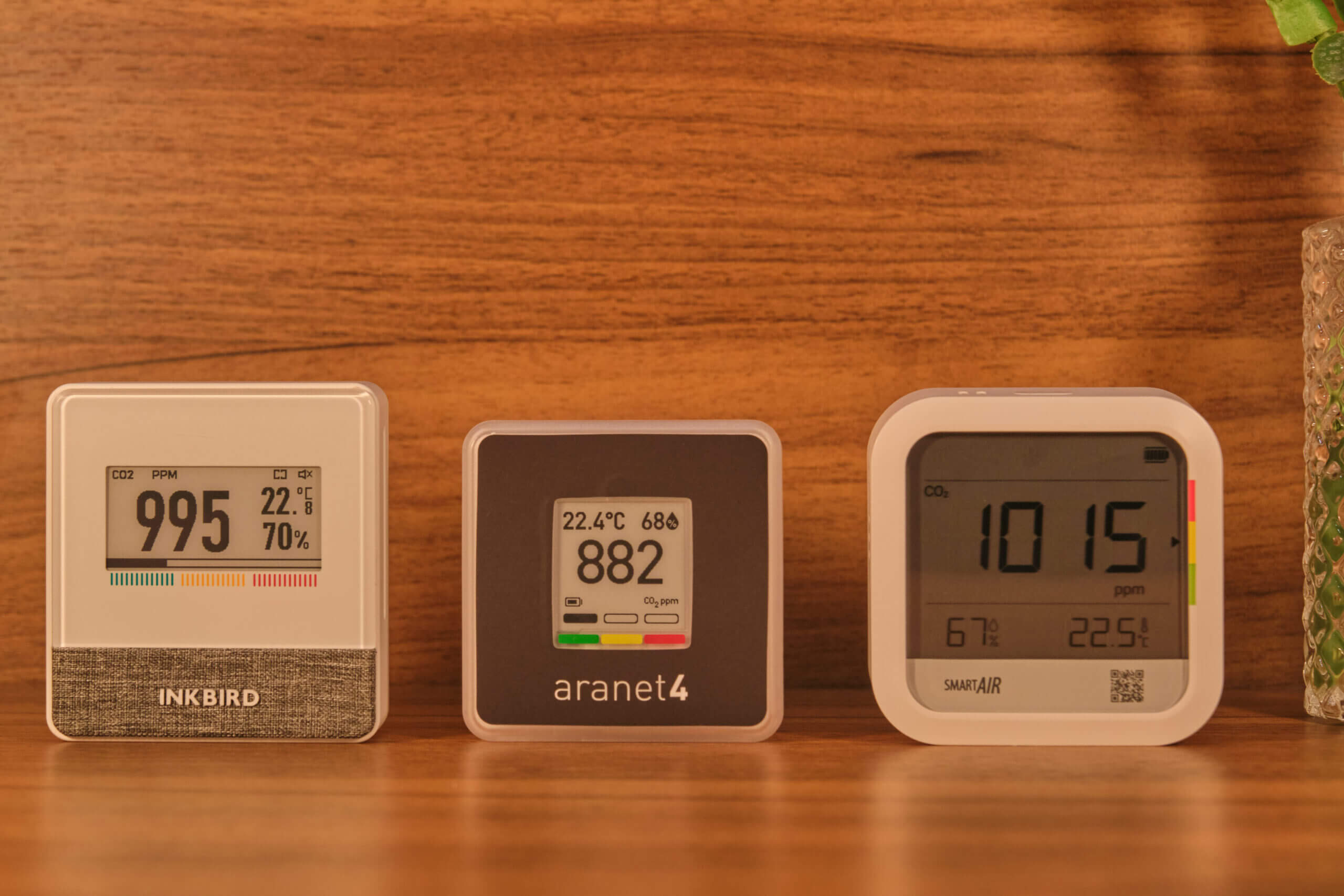
Best Carbon Dioxide Monitor ($150+)
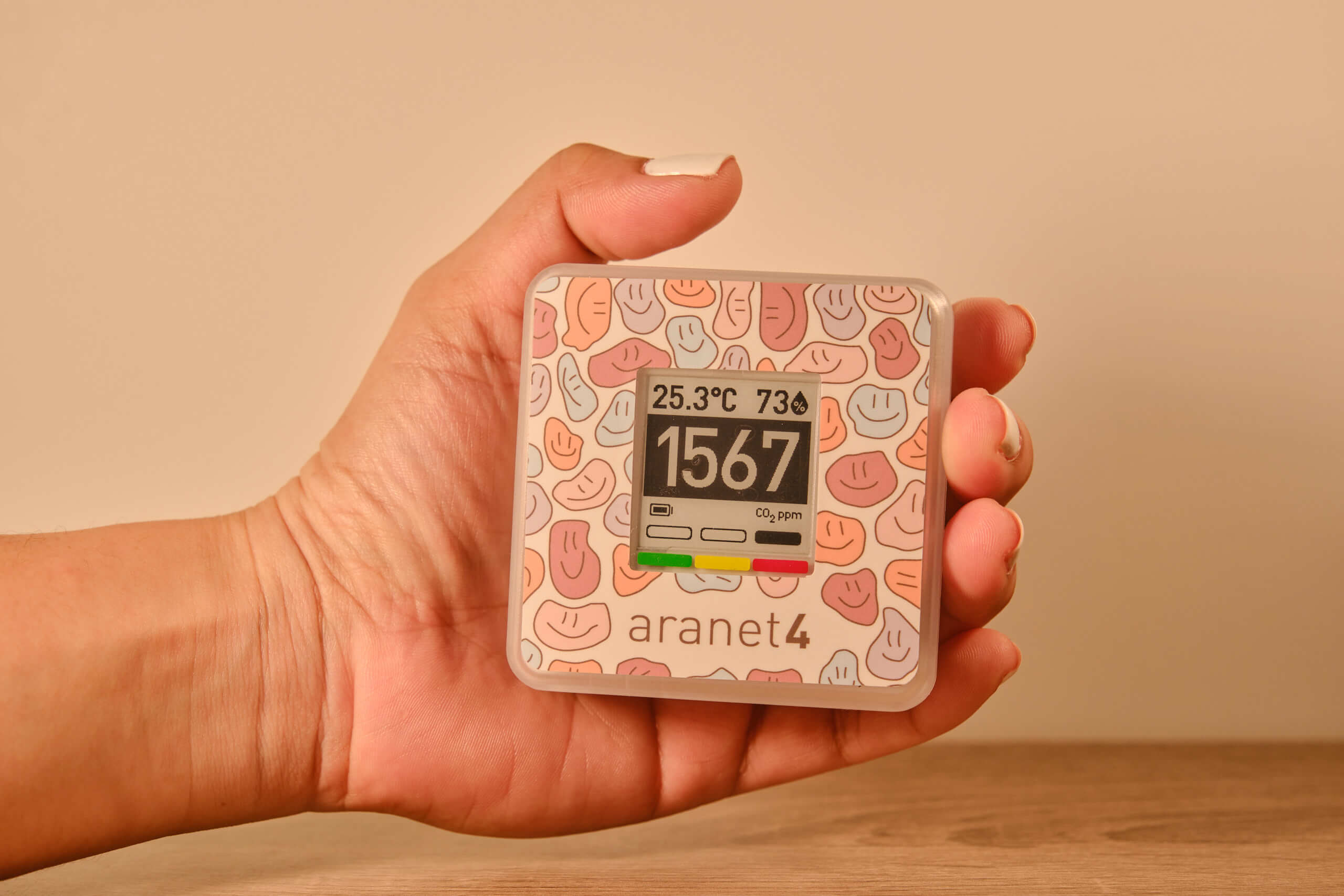
Sensor Type: NDIR
Battery Life: Up to 4 years
Connectivity: Aranet App
Price: $250 (but regularly found as low as $170)
Other Sensors: Humidity, temperature & atmospheric pressure
Calibration Type: Manual
Prefer video? Watch my YouTube review here.
If price isn’t an issue, the Aranet4 is a monitor you’ll want to check out. While it sold for around $150 before the pandemic, its rapid increase in popularity led to a massive price increase of up to approximately $250. Thankfully, the price has recently been dropping due to increased competition, and it’s often found on sale for under $200. While I’m not a fan of the price hike – it’s a lot for a device with such a niche purpose – there is no denying that Aranet4 has set the standard for consumer-grade carbon dioxide monitors.
There are two models of the Aranet4 – the Home and Pro. For nearly everyone, the Home is the monitor to check out. However, if you are in a situation where you want to use multiple monitors with a base station, the Pro is the monitor you’ll want to opt for. Besides this increased connectivity, both monitors are essentially the same.
So, what makes the Aranet4 the most popular carbon dioxide monitor? It has incredible battery life (as long as four years!), a highly accurate NDIR sensor, a fantastic accompanying app, and is super easily pocketable. On top of this, it even receives over-the-air updates, meaning new features are added over time.
You’ll also find a relative humidity, temperature, and atmospheric pressure sensor alongside the carbon dioxide sensor. These sensors can monitor the environment or discover relationships between carbon dioxide and other variables. Combined, these features, sensors, and more make the Aranet4 a solid offering.
The Aranet4 also sports a few features that other carbon dioxide monitors on this list don’t. For example, the Aranet4 can take on-demand CO2 concentration readings via the app. This is incredibly useful for situations in which you want to know the conditions straight away.
What about the downsides? Well, the most obvious downside is the price. The Aranet4 is the most expensive carbon dioxide monitor on this list; the price isn’t justifiable for many. On top of that, the device can only use AA batteries – there’s no internal, rechargeable battery. The price of these can quickly add up if you have your monitor set to take measurements at short intervals.
However, it’s hard to find disadvantages to the Aranet4 other than the price. The device is excellent both on its own and with the accompanying app. Furthermore, it supports manual calibration and stores 30 days of data on your paired smartphone. Perhaps its biggest advantage, however, is that it is super portable. The only more portable device on this list is the Vitalight carbon dioxide monitor!
Best Carbon Dioxide Monitor ($100 – $150)
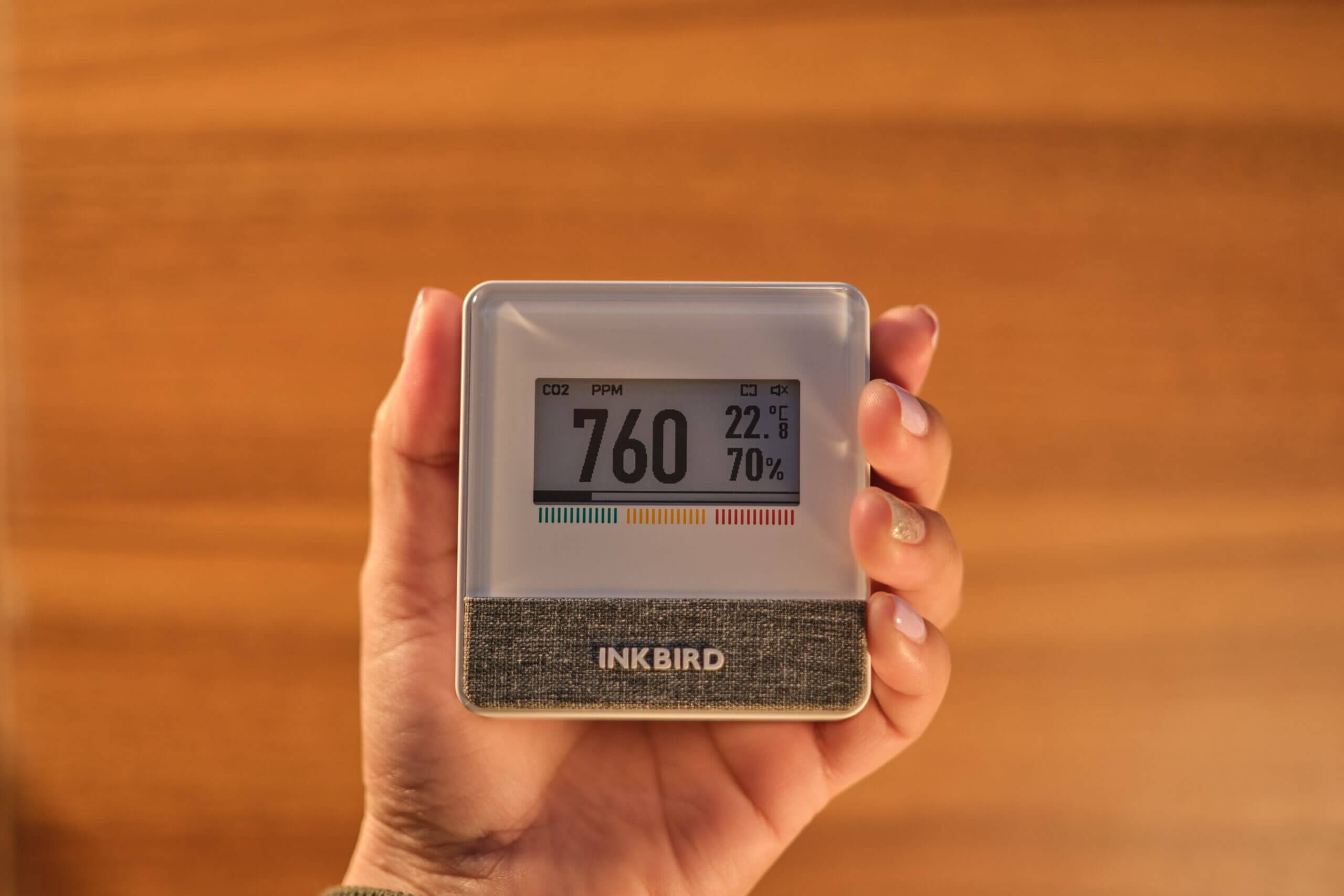
Sensor Type: NDIR
Battery Life: Up to 4 years
Connectivity: INKBIRD App
Price: $169 (but often found as low as $100)
Other Sensors: Temperature, relative humidity & atmospheric pressure
Calibration Type: Manual & automatic (user toggleable)
If the pricey Aranet4 Home is within your budget, that’s also your best choice for a portable carbon dioxide monitor. However, if your budget doesn’t quite stretch that far, the significantly cheaper INKBIRD IAM-T1 offers 95% of the Aranet’s functionality at a lower price.
The IAM-T1 is clearly inspired by the Aranet, and I don’t think it’s a bad thing. While the device is slightly larger in all dimensions, it’s easily baggable and fits in larger pockets. While it isn’t always pocketable, I haven’t found this to be an issue because the connectivity and app are great, meaning I can quickly check the carbon dioxide concentration even when the device is in my backpack.
The INKBIRD IAM-T1 features a carbon dioxide sensor alongside temperature, relative humidity, and atmospheric pressure sensors. The CO2 sensor is a NDIR sensor from Senseair, whereas the other three sensors are from Sensirion. However, both of these are trusted names within the environmental monitoring space, and I found the NDIR sensor to be accurate in my tests.
While the app for the IAM-T1 is simple, it offers all of the essentials. Here, you can manually calibrate the device or even enable automatic calibration on an eight-day cycle. However, as usual, I don’t recommend automatic calibration unless you are sure your device receives enough exposure to ambient CO2 levels.
Within the app, you can enable the device’s alarm, choose how often it activates, set CO2 level thresholds, and more. The app also allows you to view data for up to one year, and you can quickly export data as a text file if you want to dive deeper into the results. On that note, the device can also hold local data for one month.
The device’s battery life is around four years, with a ten-minute interval on readings. Realistically, however, this interval isn’t very useful, and you’ll want to set the device to a one or two-minute interval. Luckily, even with these settings, the batteries should last many months.
While it is larger than the Aranet4 and Vitalight Mini CO2 Detector, this monitor is my top portable CO2 monitor pick as it’s cheaper than the Aranet with almost the same functionality and is far more feature-packed than the cheaper Vitalight device.
Best Carbon Dioxide Monitor ($50 – $100)
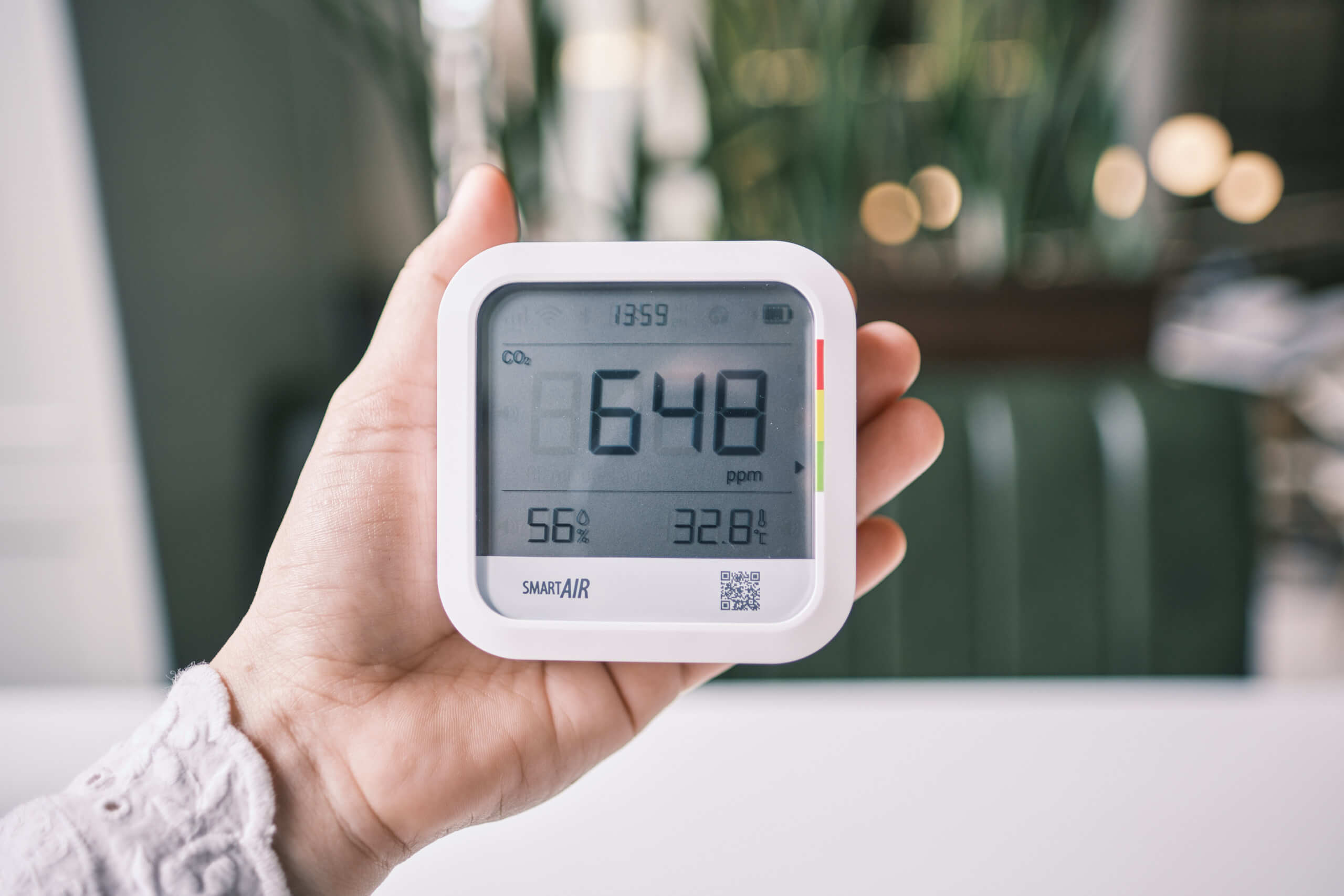
Sensor Type: Photoacoustic NDIR
Battery Life: 6-30 days
Connectivity: Qingping IoT App + Web dashboard (subscription service)
Price: $70
Other Sensors: Temperature & relative humidity
Calibration Type: Manual & automatic
The SmartAir CO2 Monitor (also called the Qingping CO2 Monitor) is an inexpensive carbon dioxide monitor that has recently changed the game. Before this monitor, you had to spend well over $100 to get a monitor such as the INKBIRD IAM-T1 or Aranet4 Home to have advanced features such as data exporting, app connectivity, and more. However, this monitor has since made all these features far more accessible by significantly lowering the price of such a monitor.
The SmartAir CO2 Monitor is made by Qingping, the company that created the Qingping Air Quality Monitor and Air Quality Monitor Lite. Both of these are fantastic devices, and when I heard that they had released a dedicated carbon dioxide monitor in collaboration with SmartAir, I was very excited.
Luckily, the SmartAir CO2 Monitor hasn’t disappointed. This NDIR-based monitor uses a Sensirion SCD40 – a carbon dioxide sensor that I’ve found to be very accurate in my testing. In fact, this monitor easily keeps up with the Aranet4 Home regarding accuracy.
The SmartAir CO2 Monitor trades blows with the more expensive monitors on this list and has some benefits over the pricier alternatives. However, it also has a few disadvantages and one frustrating downside. This downside is that while the SmartAir CO2 Monitor has both Bluetooth and WiFi, it only sends data via WiFi, meaning the app is useless when you are out and about with the monitor. While the data can store almost 3000 data points locally and will be uploaded to the app as soon the device connects to WiFi again, it’s frustrating that you can’t use the app while on the move.
On the flip side, the SmartAir CO2 Monitor relies on an internal battery with a 6-30 day battery life (depending on your CO2 measurement and uploading intervals). I love having an internal battery with good battery life, as it means I don’t need to ensure I always have AA batteries on hand. If you have the Aranet4 Home set to record every minute, you’ll need new AA batteries every few months, and the cost can quickly add up.
Since the SmartAir CO2 Monitor uses the Qingping ecosystem, you can use the Qingping IoT app to view data from not only this monitor but any other Qingping monitors you have. If you already have a Qingping Air Quality Monitor or Air Quality Monitor Lite, this alone might be enough of an incentive to purchase the SmartAir CO2 Monitor!
Best Carbon Dioxide Monitor (Less than $50)
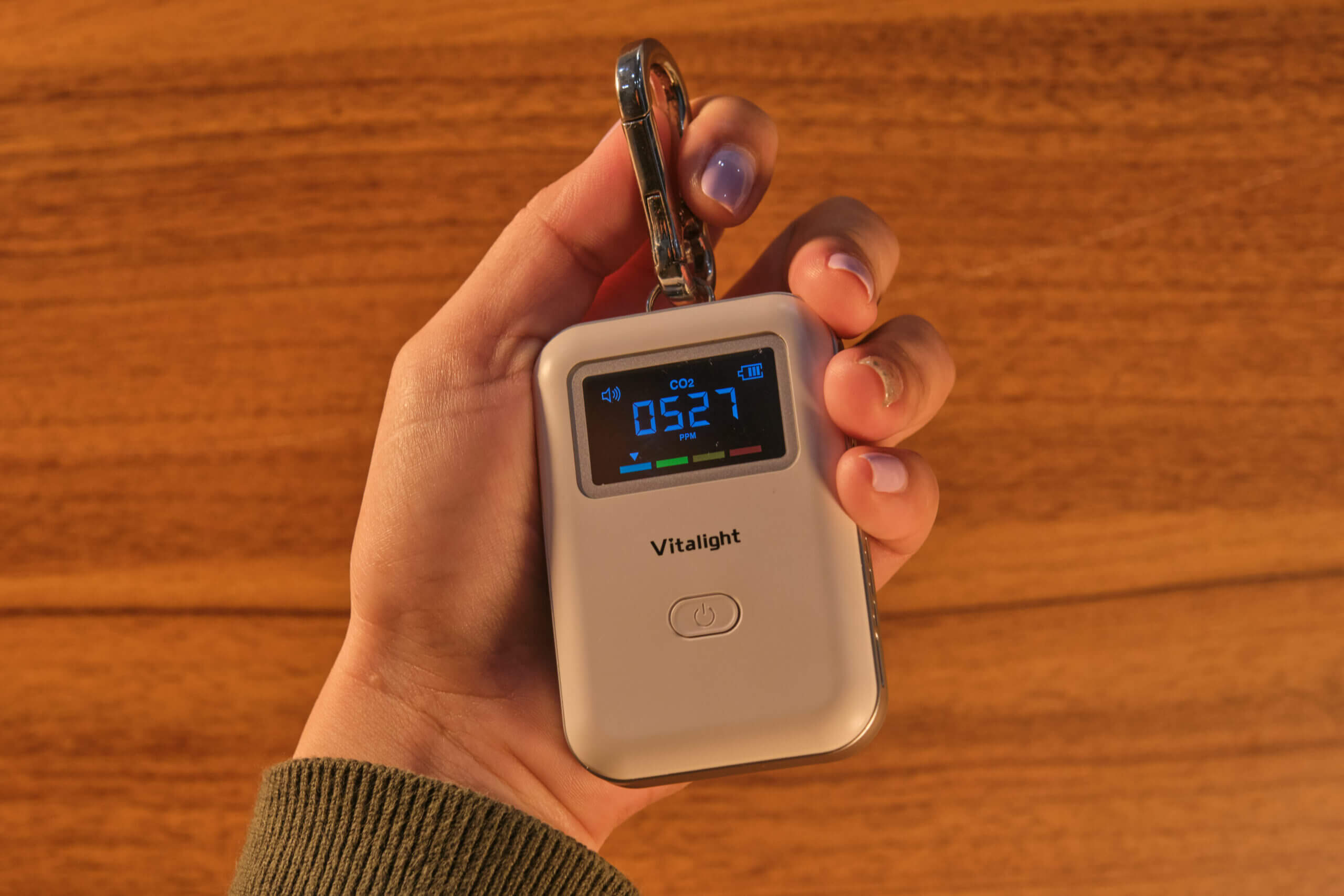
Sensor Type: NDIR
Battery Life: Up to 8 hours
Connectivity: N/A
Price: $40
Other Sensors: N/A
Calibration Type: Manual & automatic
Prefer video? Watch my YouTube review here.
The Vitalight Mini CO2 Detector is a very affordable carbon dioxide monitor costing only $40- $50. While the monitor does have flaws, the exceptionally low price for an NDIR-equipped monitor makes it a very appealing device worth considering.
The Vitalight Mini CO2 Detector is a small, minimal device. Looking around the device, you’ll find only a few intake vents, a USB-C charging port, a single button, and a small screen. There is no connectivity, relative humidity, temperature sensing, or other frills. It’s a simple device designed to monitor the carbon dioxide concentration at any time – nothing more, nothing less.
Besides the affordable price, the Vitalight Mini CO2 Detector’s biggest benefits are the USB-C-powered battery and exceptional portability. Unfortunately, these benefits come alongside a few flaws.
Firstly, the battery life is quite short, at only eight hours. While this will allow you to use the device throughout the day at work or school, it’s a frustrating disadvantage of the device. I hate having so many devices to charge, and the Vitalight Mini CO2 detector is yet another device requiring daily charging.
Secondly, and more importantly, the device has an auto-calibration feature, which can render the device inaccurate if you don’t know how to account for this ‘feature’. In my full review, I discuss how you can avoid the issues caused by auto-calibration, and I recommend reading that article before purchasing a Vitalight.
However, if you can manage the auto-calibration feature, the device is surprisingly accurate – especially considering the price. I often find the Vitalight reading very similar (or identically) to far more expensive monitors such as the Aranet4.
Best All-in-One Carbon Dioxide Monitor ($100+)
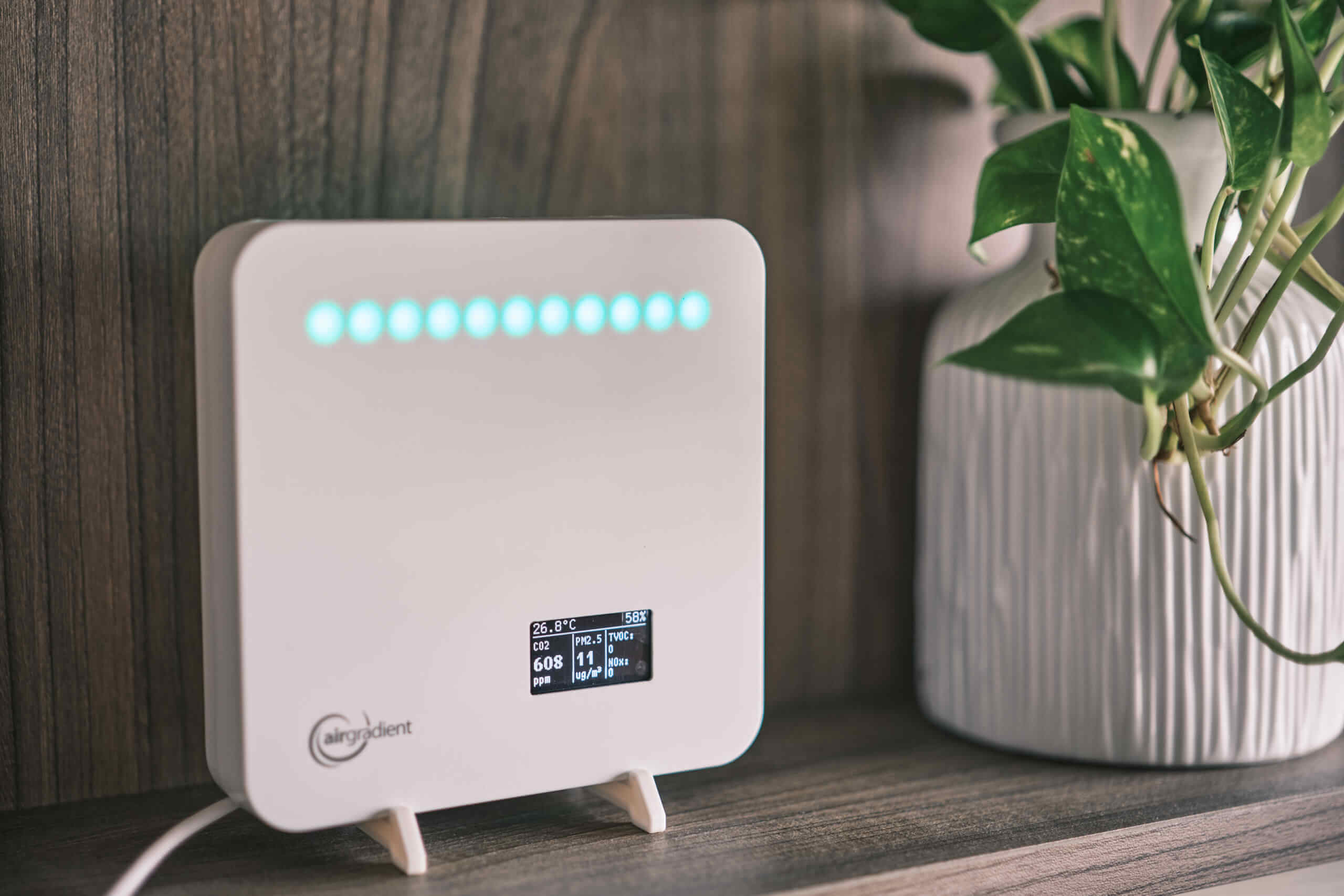
Sensor Type: NDIR
Battery Life: N/A
Connectivity: Web Dashboard
Price: $138 (DIY), $195 (assembled)
Other Sensors: PM1, PM2.5, PM10, VOC, NOx temperature, relative humidity
Calibration Type: Manual & Automatic
Suppose you want an indoor carbon dioxide monitor that also happens to monitor a large range of other indoor air pollutants. In that case, the AirGradient ONE might be exactly what you’re looking for. This monitor uses a Senseair S8 sensor, which is proven to be an accurate CO2 sensor that provides reliable results. However, it has a built-in auto-calibration feature, meaning you will want to monitor its readings to ensure it isn’t losing accuracy. Luckily, manual calibration is also supported.
What makes the AirGradient ONE so compelling is the pricing. Compared to other monitors that feature the range of sensors you’ll find in this device, you’re generally looking at $200-$400. However, the AirGradient ONE comes in at only $138 – provided you’re willing to build the monitor yourself. Before you say, ‘I can’t possibly do that!’, don’t worry – it’s an incredibly easy process that takes only 10 minutes.
No soldering is required; all you need to do is slot the included components into their slots. Of course, instructions are provided. I recently got this kit, and I was amazed at how easy it was to assemble the monitor – really, it’s an exceptionally easy process. However, if you don’t want to DIY, you can purchase a pre-built kit for $195. While this is still a fantastic deal, it’s not quite as amazing as buying such a high-quality monitor for less than $150.
The AirGradient ONE connects via WiFi and uploads data to a web dashboard. This dashboard will allow you to view current and historical data from the device, and it also allows you to customise the LEDs on the device to adjust their thresholds or the pollutants they represent. While there is no smartphone app, the web dashboard is powerful, and I haven’t found it to be lacking.
This device doesn’t have an internal battery, so it must always be powered. That said, it’s perfect if you need a monitor for your home or office. I also imagine that this monitor would excel in classrooms and small businesses that want to monitor CO2 and other indoor pollutants to improve productivity.
Overall, the AirGradient ONE is a fantastic indoor carbon dioxide monitor that will also allow you to track other potentially harmful indoor air pollutants. With both DIY and assembled kits available, this device has a lot of flexibility. Oh, and I forgot the best part – each component is user-replaceable, and both the hardware and software are open-source.
Best All-in-One Carbon Dioxide Monitor (Less than $100)
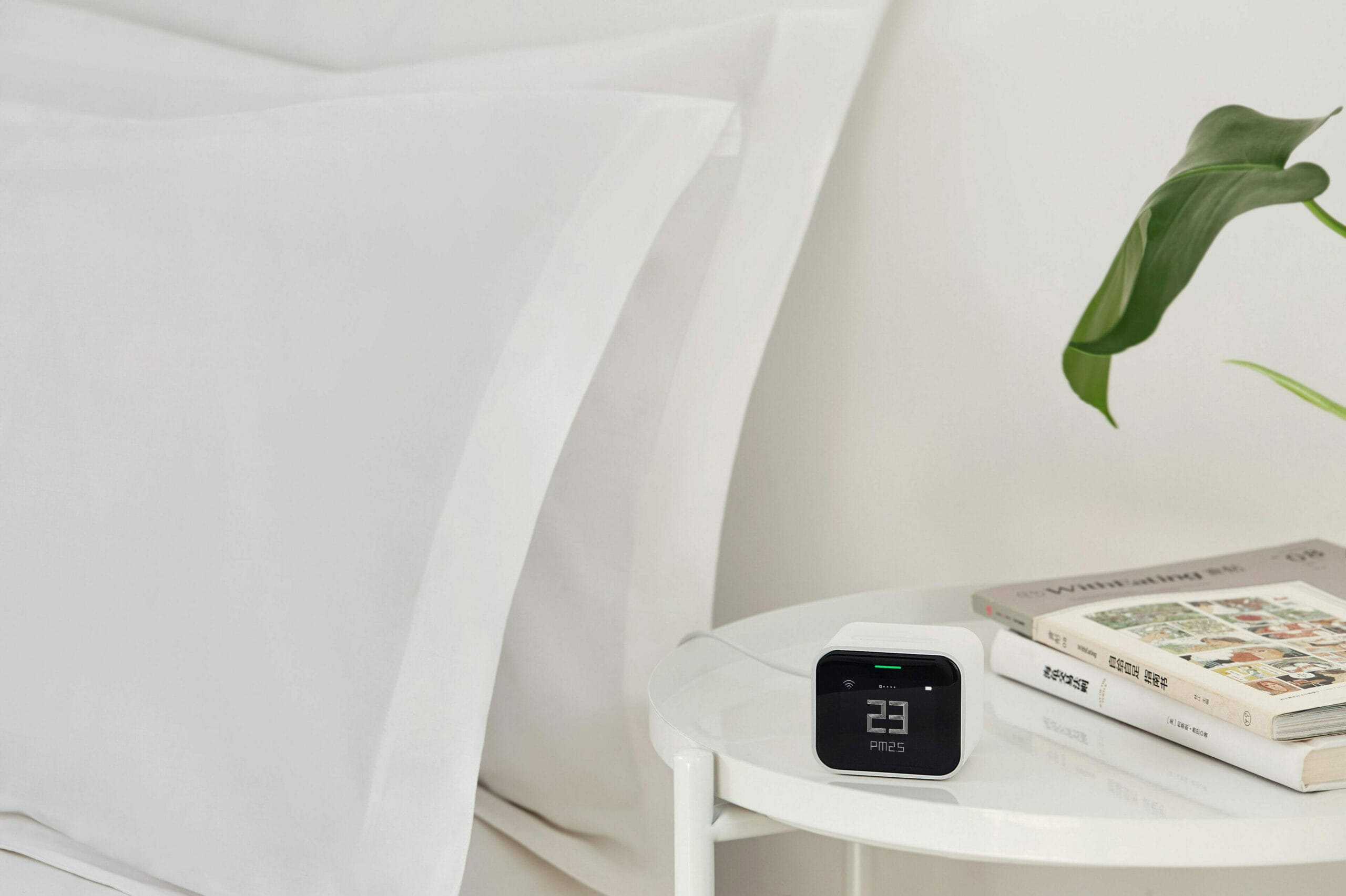
Sensor Type: NDIR
Battery Life: Up to 8 hours
Connectivity: Qingping+ App, Homekit
Price: $90
Other Sensors: PM2.5, PM10, temperature, relative humidity
Calibration Type: Manual
The Qingping Air Monitor’s little brother, the Qingping Air Monitor Lite (they could find a better naming scheme), is also a great choice for a more complete indoor air quality monitor. While the monitor features a carbon dioxide sensor, it is also accompanied by a PM2.5, PM10, relative humidity, and temperature sensor. For such a little package, it’s very complete!
Like its bigger sibling, the Qingping Air Monitor Lite is not intended to be portable. While it houses a similar-length eight-hour battery, and its form factor is perfect for a portable device, it isn’t intended to be used on the go. For one, the battery life is a bit too short, and furthermore, you have to wait about five minutes after turning the device on to get an accurate reading. Not great while out and about!
The Qingping Air Monitor Lite is a great choice as a desk-based carbon dioxide monitor. The larger Air Monitor feels cluttered and overwhelming, but the small Air Monitor Lite is exceptionally simple. You can set the screen to show a single reading (these can be scrolled between), and that’s all that is displayed on the screen.
Now, this does make the device a bit too simple. You’ll find yourself scrolling through all the sensor readings to get a full overview of your indoor air quality. Since you need to scroll through the CO2, PM2.5, PM10, temperature and relative humidity readings, this can take a good 10 seconds.
If you can manage this small inconvenience, the Qingping Air Monitor Lite has an accurate, albeit conservative, carbon dioxide sensor. Even after manually calibrating the device (which is possible!) I found it to record readings about 100ppm lower than my other devices.
In reality, though, this isn’t much of an issue. At the end of the day, whether you’re seeing 1400ppm or 1500ppm, both indicate that better ventilation is needed. Therefore, this discrepancy in readings is minor enough to be overlooked.
The Qingping+ App can also be used with the Air Monitor Lite, allowing the user to change basic settings and see historical data. While the data viewing is limited to 15-minute intervals in the 24-hour view and 1-day intervals in the 30-day view, the ability to view and export data is a nice addition.
The Qingping Air Monitor Lite also supports Apple Homekit, so if you’re an Apple user, you’ll be able to integrate this little air quality monitor into your smart home. Even though I use an iPhone, I found myself using the Qingping+ app more often as it provides more data.
Best Connected Carbon Dioxide Monitor
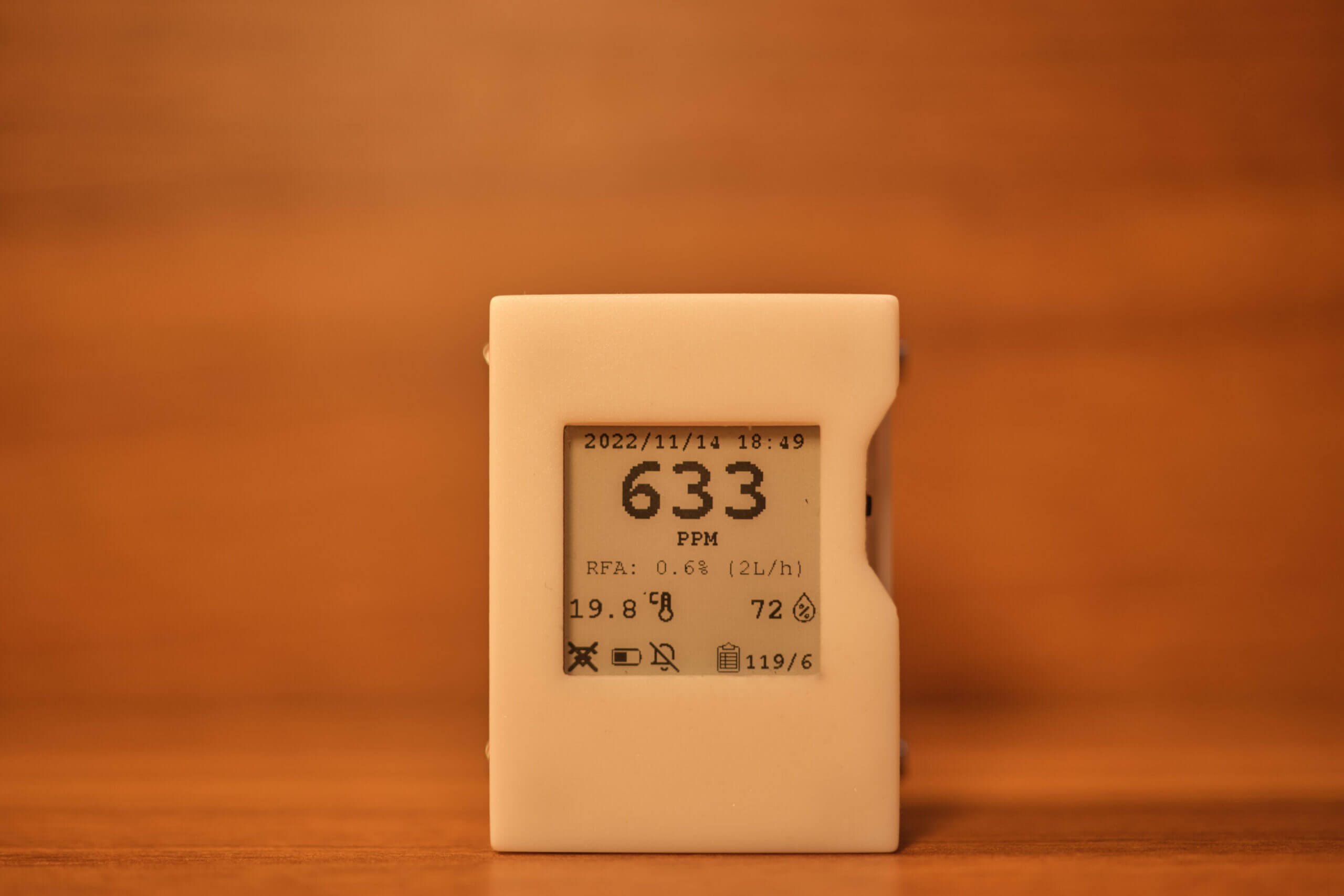
Sensor Type: Dual-beam NDIR
Battery Life: Up to 8 hours
Connectivity: WiFi
Price: $150 ($199 CAD)
Other Sensors: Temperature & relative humidity
Calibration Type: Manual
CO2.Click offers two models – the connected Model C and the standalone Model D. The price difference between the two is 10 CAD, and I recommend the Model C to everyone. While the Model D is a great monitor, the connectivity of the Model C is invaluable.
Both CO2.Click monitors use a top-of-the-line Sensirion SCD30 sensor that provides the same accuracy level as the significantly more expensive Aranet4 Home. Temperature and relative humidity sensors are also included in this carbon dioxide monitor.
While the CO2.Click Model C includes a built-in battery, battery life is short at around eight hours. This is competitive with the Qingping carbon dioxide monitors and the Vitalight but also falls far short of the Aranet4. For this reason, I would recommend the Aranet4 as a portable monitor if you can afford it.
With that said the Model C is a fantastic choice for a home, office, classroom, or store monitor. It’s small and unobtrusive, well-connected, and the data can easily be shared via a QR code. The best part? You can add multiple monitors to the WiFi dashboard and track them all in one place.
Despite being relatively affordable, the CO2.Click Model C features high-end hardware and advanced features. The dual-beam NDIR sensor makes this the only dual-beam device on this list, and the device sports no auto-calibration (which is a big advantage). On top of this, Model C supports data exporting (with notes), adjustable reading intervals, and even allows you to set the CO2 offset.
The biggest downside with the CO2.Click is the build quality. While it is by no means bad, the 3D printing of the device isn’t quite up to par with other devices on this list – perhaps except for the Vitalight Mini CO2 Detector, which feels cheap.
However, besides this, I struggled to find downsides to CO2.Click. It’s a fully capable monitor with tons of features and great accuracy. What makes it even more compelling, though, is the price. While it’s far from the cheapest monitor on this list, what you get for the price makes it a great choice for anyone looking for a mostly static indoor carbon dioxide monitor that can be portable when needed.
Best Desk-Based Air Pollution Monitor
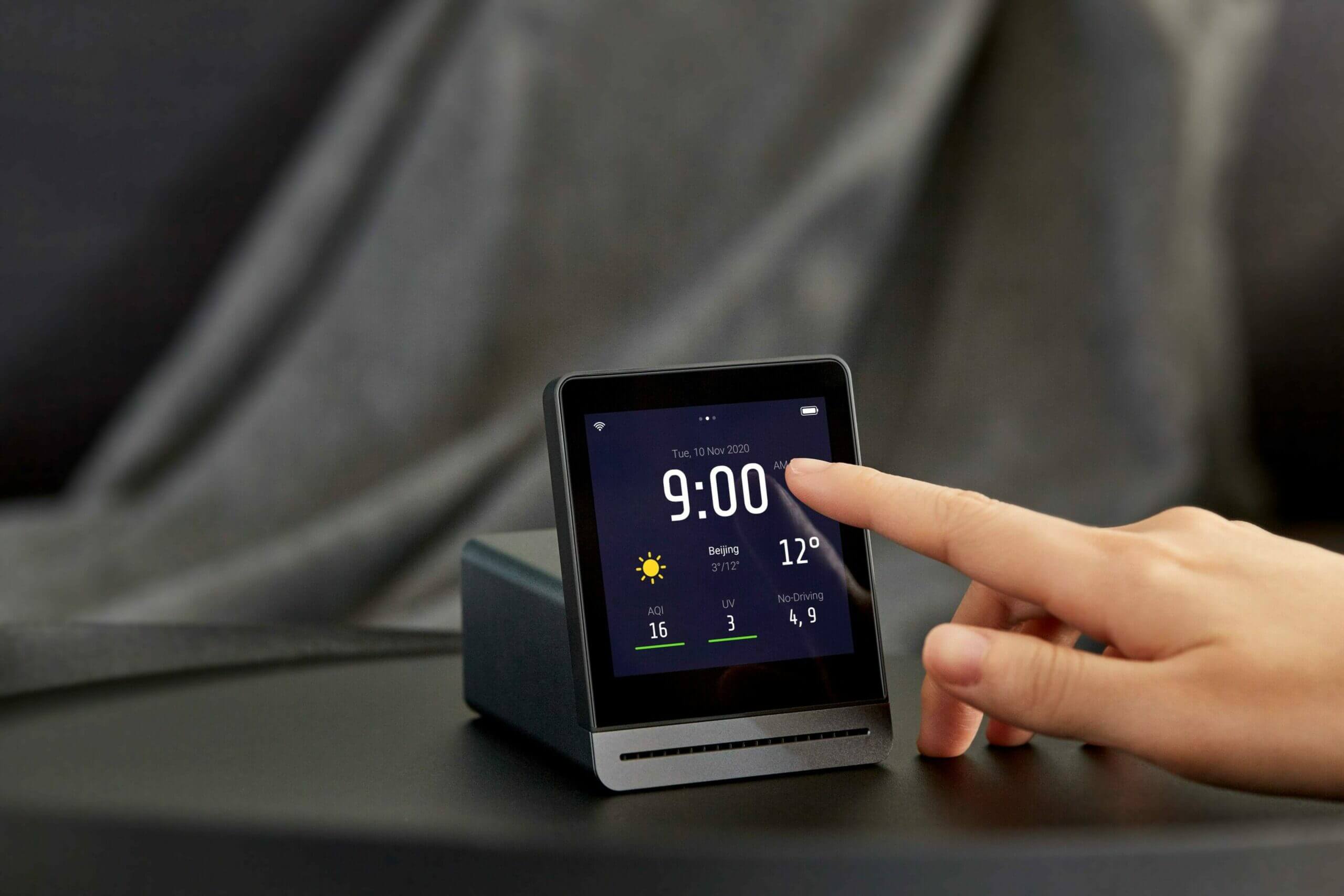
Sensor Type: NDIR
Battery Life: Up to 7 hours
Connectivity: Qingping+ App
Price: $130
Other Sensors: PM2.5, tVOC, temperature, relative humidity
Calibration Type: Manual
If you want a carbon dioxide monitor that provides greater insight into your indoor air quality, the Qingping Air Monitor might be the device for you. This indoor air quality monitor features a CO2 sensor alongside PM10, tVOC, relative humidity, and temperature sensors. In other words, it’s the most complete indoor air quality monitor on this list.
The Qingping Air Monitor is intended to be used as a tabletop or shelf monitor. While it has a small internal battery, its life is short, and you’ll be lucky to get eight hours from it. Furthermore, the product’s design shows that it isn’t portable – I would worry about it breaking in my backpack.
However, the Qingping Air Monitor excels at being a not-so-portable indoor air quality monitor. With a responsive touch screen, a great accompanying app, and a high-resolution (albeit cluttered) display, there isn’t much to wish for on the Qingping Air Monitor. Considering its feature set, it’s also affordably priced!
In my testing, I found the carbon dioxide sensor in the Air Monitor to be quite accurate compared to other carbon dioxide monitors. While the readings were a bit conservative, the CO2 monitor features a recalibration feature that allows users to manually recalibrate the sensor.
Testing done by SmartAir has also shown the PM2.5 sensor to be accurate. However, the tVOC sensor does have a larger margin of error, with the sensor only offering accuracy within 20% of the actual tVOC concentration. The good news? This is more than accurate enough to identify overall trends in your air quality and act accordingly.
On the Qingping+ App (the app which you’ll want to download to get the most out of the monitor), you can view historical data and change the measurement units of the device. While the app is otherwise quite sparse, it’s straightforward to use, and I never had any issues with lag or crashing.
That said, a few changes would improve the Qingping Air Monitor. Firstly, the app needs to support more time brackets in its graphs. Secondly, and more importantly, the display can be quite cluttered – I would like to see a feature allowing the user to display only the pollutant they are interested in.
Regardless, these issues are far from deal-breakers. This is a fantastic choice if you want a device that you can glance at to get an overview of your indoor air quality. If you’re looking for something smaller, simpler, or cheaper, you might want to check the smaller Qingping monitor, the Qingping Air Monitor Lite.
Best Ultra-Small Carbon Dioxide Monitor
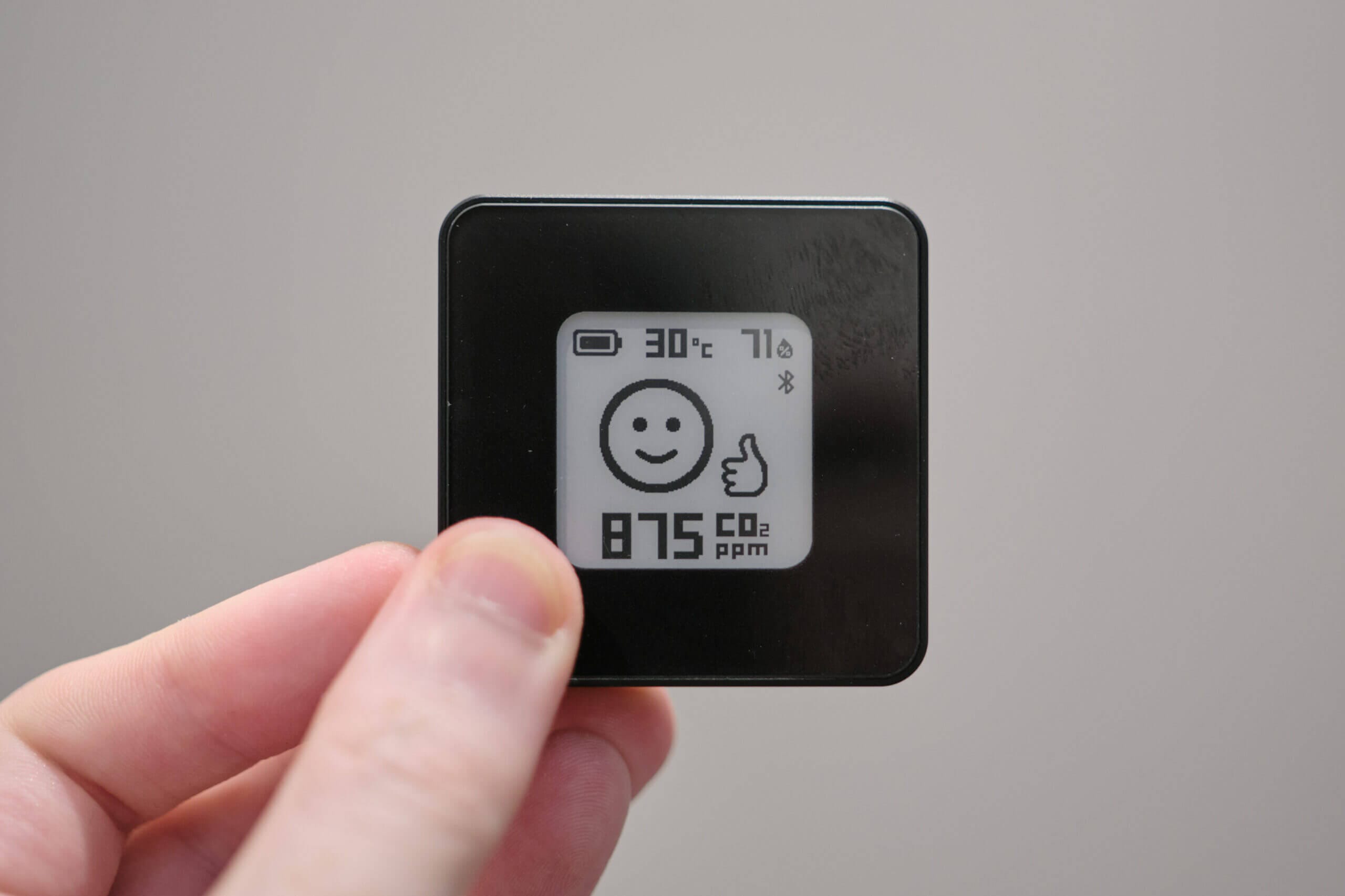
Sensor Type: Photoacoustic NDIR
Battery Life: 5-30 days
Connectivity: Bluetooth
Price: $190
Other Sensors: Temperature, relative humidity
Calibration Type: Manual & automatic
If you want the smallest and most inconspicuous carbon dioxide monitor out there, the AIRVALENT monitor is your best choice. While it might not look like it at first glance, this monitor is half the size of the Aranet4 Home, and even the Vitalight Mini CO2 Detector looks massive next to it. Combined with the approachable way this monitor shows information, it’s a great device for people who don’t want and would prefer that their CO2 monitor goes unnoticed.
The AIRVALENT carbon dioxide monitor uses a Sensirion SCD41 photoacoustic NDIR sensor. While this sensor is very accurate at room temperatures (less than 30 degrees Celsius), I did find that it began to read quite inaccurately when the temperature was between 30 and 40 degrees. That said, I don’t see this as an issue for most users, as this device will primarily be used indoors. The SCD41 performs very well in these conditions, and I’ve found it accurate in my testing.
While the AIRVALENT CO2 monitor can be used as a standalone device, you will want to use Bluetooth and the accompanying app on your smartphone to get the most out of it. The app allows you to change the settings and view historical data from the monitor. It also allows you to change the device’s display with various layouts and designs. This is a unique feature among CO2 monitors, and I love having a little customisation available.
Battery life is a common concern with such a small monitor. However, the AIRVALENT monitor performs surprisingly well in this regard, and it has between five and 30 days of battery life, depending on the measurement interval you set (one to fifteen minutes). Personally, I set my monitor to take readings every minute, and I’ve found the claimed five days of battery life to be about right.
The biggest downside of this monitor is the price. While technically, the Aranet4 is more expensive at its normal price, it’s often on sale and can be found for less than this monitor. Though it does perform well, this makes it a tough sell as the Aranet has a stellar reputation. That said, there are some significant advantages with this monitor, too.
If you’re looking for a compact carbon dioxide monitor that you don’t need to worry about charging every night, the AIRVALENTCO2 monitor is not only a great choice, but it’s really your only choice. This monitor is perfect for giving children to take to school, too, as it’s compact and straightforward. With the range of easy-to-understand displays you can alternate between, it’s really the perfect choice for anyone looking for a simple-to-use monitor that has advanced functionality.
Carbon Dioxide Monitor FAQ
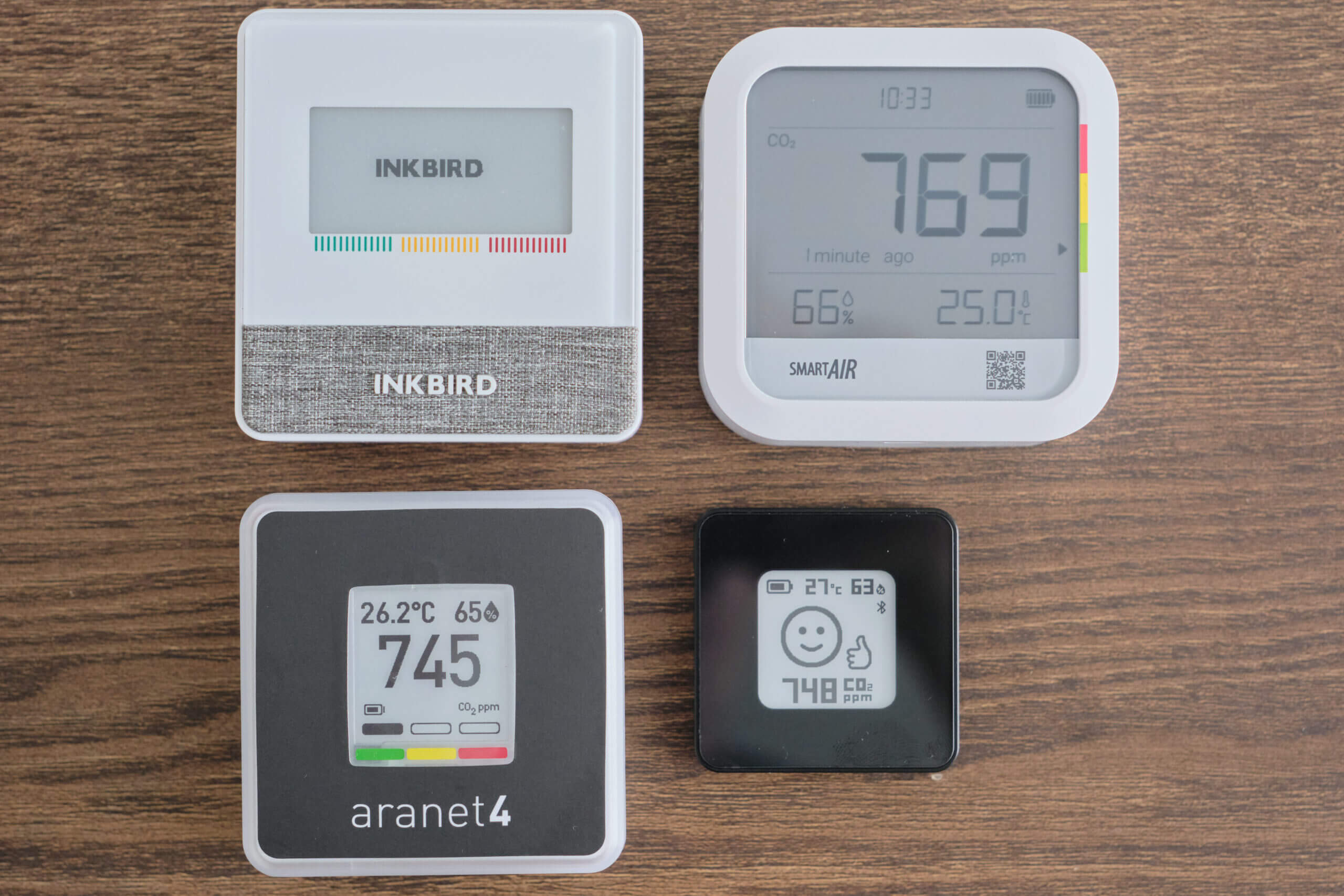
Do I Need a Carbon Dioxide Monitor?
Probably not. However, a carbon dioxide monitor is a great way to monitor ventilation and having one can allow you to take action regarding ventilation and masking.
How Much Are Carbon Dioxide Monitors?
Consumer-grade carbon dioxide monitors start at around $50 and can sell for as much as $300.
What Do I Need in a Carbon Dioxide Monitor?
You’ll want to ensure the carbon dioxide monitor has an NDIR sensor, allows for manual calibration, and has a battery (if you want to use it on the go).
What’s the Best Carbon Dioxide Monitor?
It depends on your needs. The Vitalight Mini CO2 Detector is the most portable, but the Aranet4 is the most accurate.
What’s a Good Carbon Dioxide Concentration?
Whenever possible, you’ll want to stay below 800ppm. If this isn’t possible, under 1000ppm is generally considered safe.
Have Questions or Comments?
Join the discussion on the BreatheSafeAir Community Forum. Ask any questions you have about air quality or adjacent topics and get quick answers!
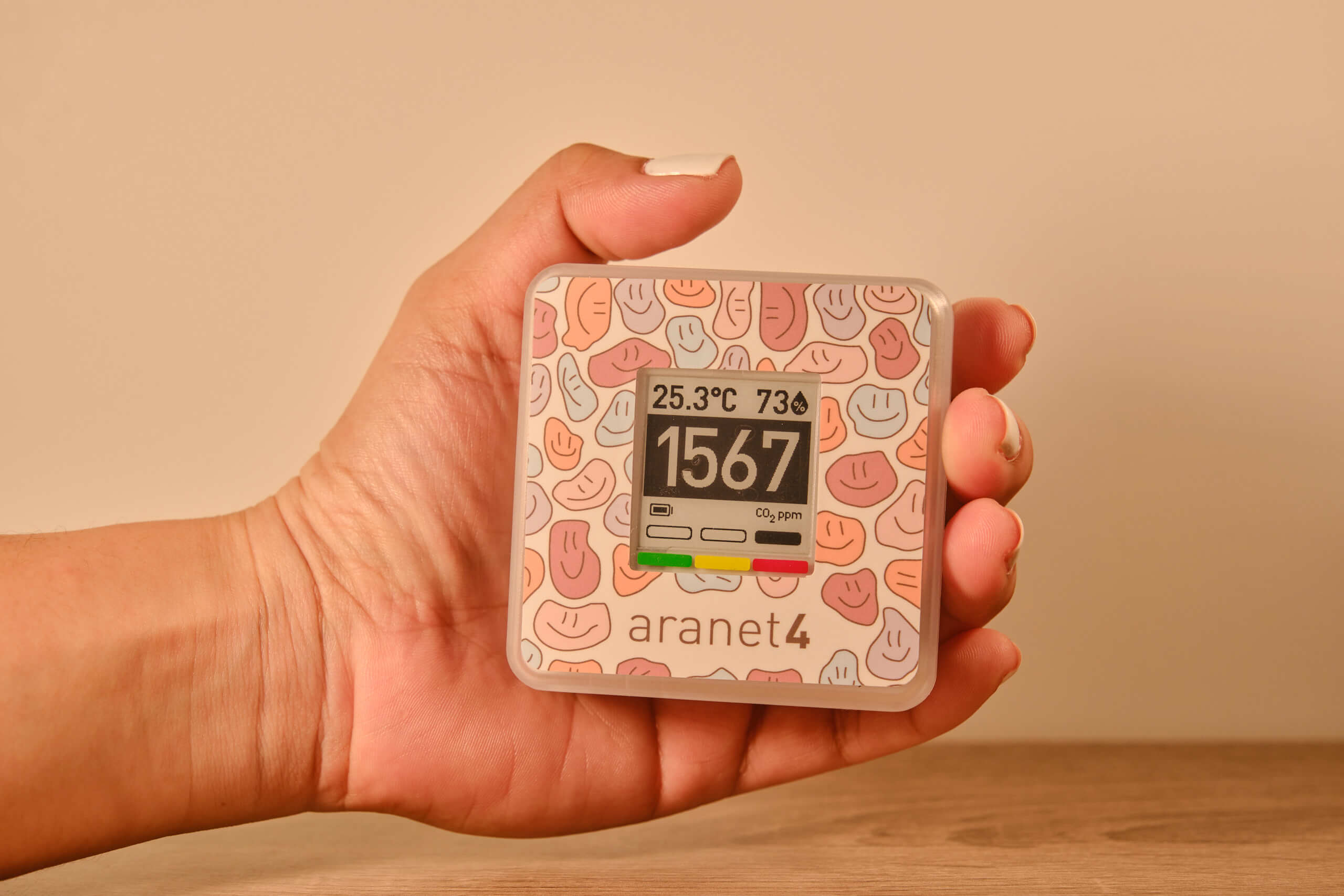
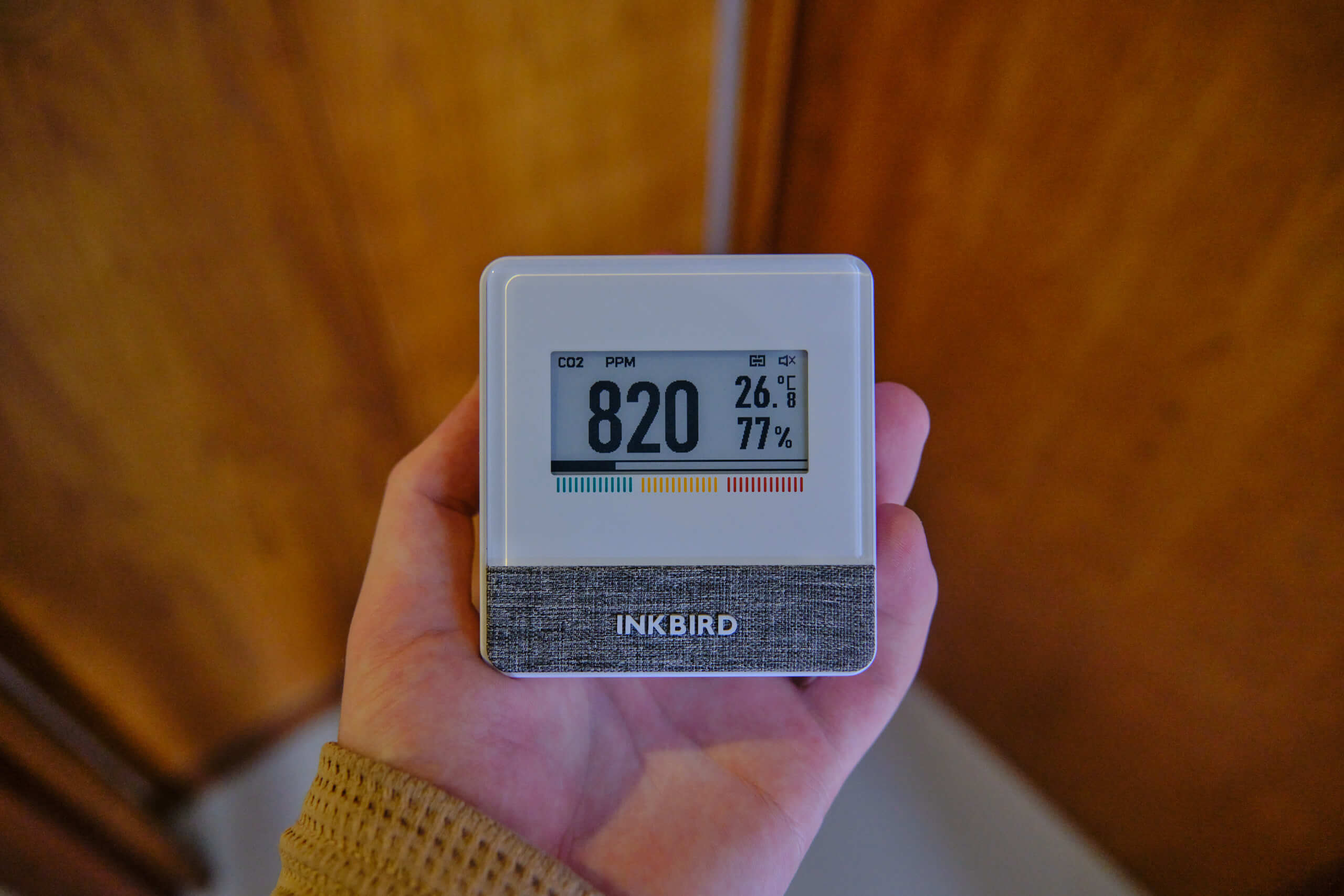
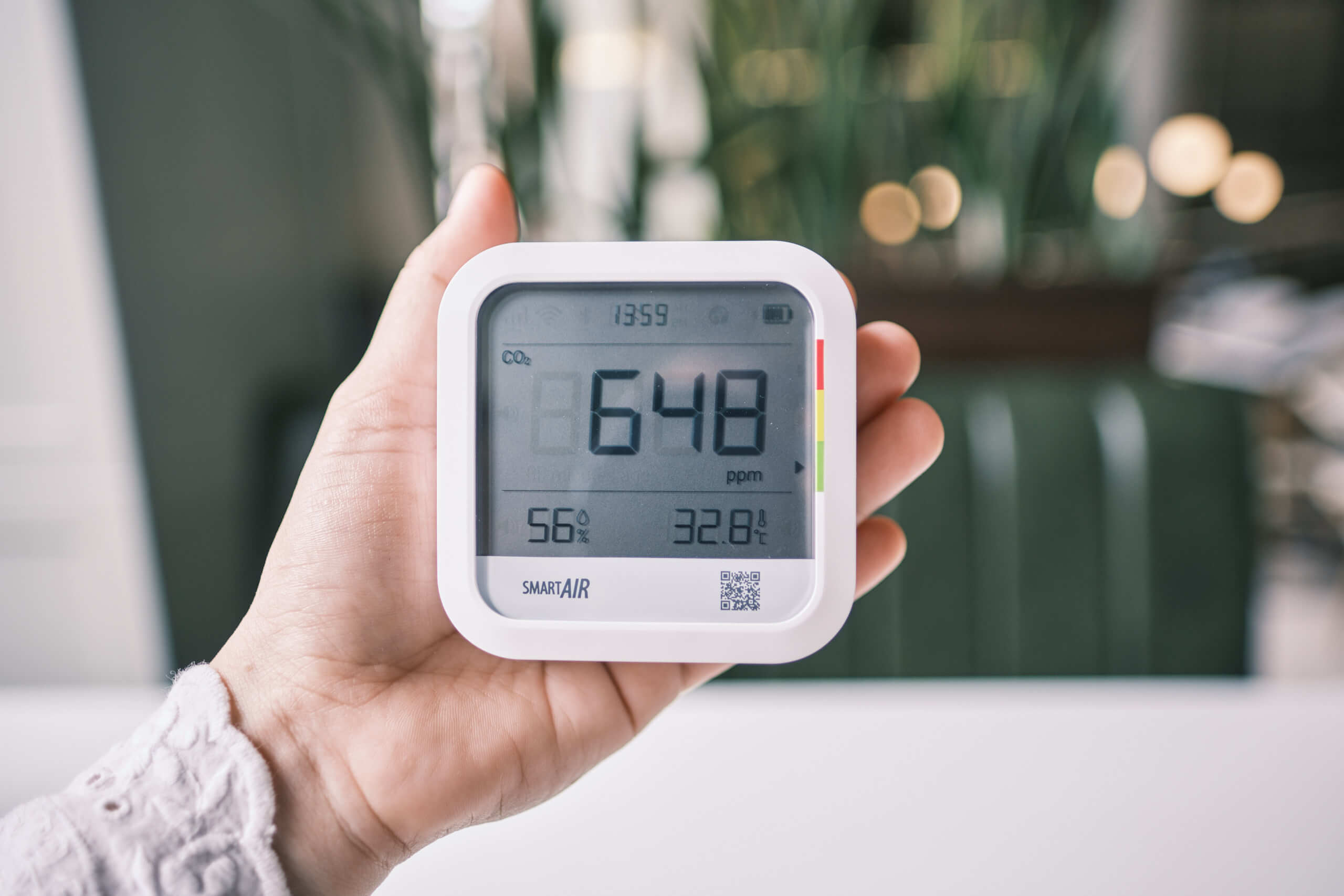
Thank you for the article.
I have noticed that a lot of the NDIR CO2 meters are relatively poor in accuracy specifications and repeatability between versions, even after calibration in the normal indoor room range (550 to 850PPM). I see more than 100ppm variations for no apparent reason between the meters and in a short number of days, within the same meter.
I wonder if pressure, temperature or humidity play a role between calibration and reading. I suspect that pressure at least does. I wonder if some do an auto compensation, and some do not. This is important to know for a portable meter.
They tend to claim +/- 50ppm plus +/- 5% as a basic accuracy, which is a pretty wide range for a normal room, and it appears to be even wider than that for some reason, which is very annoying.
I would trade some features for an known good accuracy portable affordable unit. I wish I could use/create a standard environment (~1000ppm) to test them in occasionally.
Hi Larry,
While you are right in that sensors can vary quite greatly in readings, it’s also important to note that there can be a large difference between CO2 concentrations even if the monitors are placed only a foot apart – this is especially true in an environment with little to no airflow as ‘eddies’ can be formed. I believe you’re also right in that temperature and humidity impact readings – the Aranet4, for example, states the accuracy numbers on the spec sheet are only applicable at < 80% humidity. I wonder if the lack of accuracy is a technical limitation. I'm not versed enough in the science or engineering behind the products to know if it's possible (or feasible at consumer prices) to create a more accurate monitor as I agree the lack of accuracy can be frustrating!
Use of the Qingping Air Monitor Lite monitor on battery could be extended by plugging it into a portable phone charger.
Hey Larry,
You are correct to assume that pressure has a role in the CO2 measurement process – the CO2 reading is heavily affected by the atmospheric pressure (an overview available here https://www.co2meter.com/blogs/news/127454855-altitude-compensation-for-co2-sensor-modules). Unfortunately the more basic sensors do not implement this properly.
Even more muddying the waters – some sensors rely on automatic baseline calibration (basically waiting a week for the lowest reading and assuming it is 420ppm) which if rooms are not regularly (usually weekly) ventilated to achieve ~400ppm, will skew the measurements to the lower side. I.e. if the room never goes below 600ppm and automatic baseline calibration is enabled, it will assume that the actual 600ppm atmosphere is 400ppm and thus when the sensor should show, say 1500ppm, it would show 1000ppm. It is usually best to manually recalibrate your NDIRs periodically (every year or so) in the outdoor air.
The best environment to actually test a CO2 sensor is usually simple outdoor air – it should be 400-500ppm.
If you are in a place with lots of plants and it is daytime, it can go lower than that due to the plants consuming CO2, so probably don’t go into a forest when calibrating. 🙂
You can get calibrated CO2 gas to validate sensors, but with good quality (i.e. Senseair, Sensirion) I would not worry about that, or send them to a certified lab to check.
Regarding +-50ppm+-5% being a large margin – the best sensors offer +-30ppm +-3% which is very much sufficient to determine the critical >1000ppm and >1500ppm thresholds. There is indeed some inherent noise in the measurement thus you can’t really eliminate the error (unless using lab grade gear worth 10k$+), however when measuring a level of 1500 +-30ppm+-3% equates to 1455 – 1545 range, which seems good enough to see the overall picture and determine the ventilation requirements.
you can easily extend battery life from 8 to 16 hours. you familar with passive systems?
I just ordered the Qing ping plus, and am debating getting the lite too. They’re actually on sale right now on Amazon haha! I’m curious though do you have thoughts on Airthings?
Airthings is one brand of monitors that I really want to try but I haven’t yet had the chance. They look good though, and I’ve heard great things about them!
7-8 hours battery is way too optimistic for the QingPings in my experience. Mine gets 4 hours, and a friend with the Lite also gets 4 hours. Also mine does not report PM10, though apparently the Lite does (at the expense of VOC).
Even with the 20% margin of error, I’m not sure how reliable the VOC on the QingPing is. I’ve been noticing 10x swings over half an hour, with no obvious cause.
But as a desktop PM and CO2 monitor with enough battery to be moved around the house, I do love it. Don’t find the UI cluttered at all.
I can second the Vitalight being small, useful, but also drifty and annoying to keep charged. I bought mine based on the earlier review on this site, taking to mind the warning about taking it for walks.